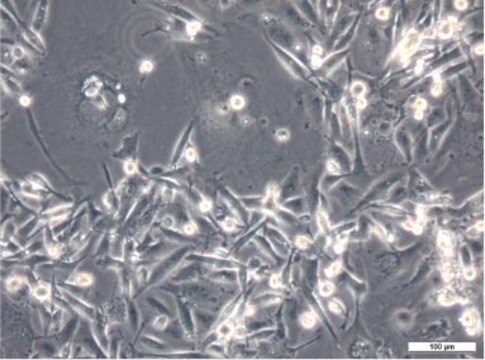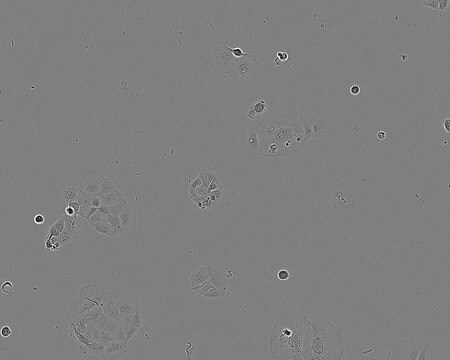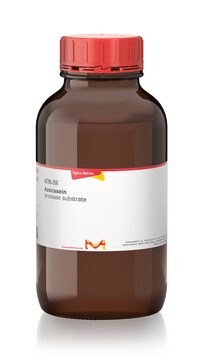推荐产品
生物源
human breast
包裝
tube of 5 μg 87012601-DNA-5UG
pkg of vial of cells 87012601-1VL
增長模式
Adherent
染色體組型
2n = 46, modal no. 72
形態學
Epithelial
產品
Not specified
受體
Reported to express the oestrogen and progesterone receptors
技術
cell culture | mammalian: suitable
相關疾病
cancer
運輸包裝
dry ice
儲存溫度
−196°C
細胞系來源
Human Caucasian breast carcinoma
細胞系描述
Derived from a malignant ascitic effusion in a 63 year old female Caucasian with infiltrating ductal carcinoma. The cells are reported to express both the wildtype and variant oestrogen receptors, progesterone receptor and other steroid hormones.
應用
Hormone and tumourigenicity studies
ZR-75-1 has been used to determine the effects of cucurbitacin E (CuE) extracted from Ecballium elaterium A.Rich., Fam. Cucurbitaceae.
DNA分析
STR-PCR Data:
Amelogenin: X
CSF1PO: 10,11
D13S317: 9
D16S539: 11
D5S818: 13
D7S820: 10,11
THO1: 7,9.3
TPOX: 8
vWA: 16,18
Amelogenin: X
CSF1PO: 10,11
D13S317: 9
D16S539: 11
D5S818: 13
D7S820: 10,11
THO1: 7,9.3
TPOX: 8
vWA: 16,18
培養基
RPMI 1640 + 2mM Glutamine + 1mM Sodium Pyruvate (NaP) + 10% Foetal Bovine Serum (FBS).
例行更新培養
Split sub-confluent cultures (70-80%) 1:3 i.e. seeding at 3-5x10,000 cells/cm2 using 0.25% trypsin or trypsin/EDTA; 5% CO2; 37°C. Cells grow very slowly, do not form a confluent monolayer and attach only lightly to the substrate. After subculture, it can take up to 7 days before cells re-attach. Detachment of cells can occur in PBS and trypsinisation can produce clumps of cells. To avoid clumping do not agitate the cells by hitting or shaking the flask while waiting for the cells to detach. When subculturing, ensure the trypsin is completely removed by centrifuging the cells and resuspending them in fresh medium.
其他說明
Additional freight & handling charges may be applicable for Asia-Pacific shipments. Please check with your local Customer Service representative for more information.
我们的科学家团队拥有各种研究领域经验,包括生命科学、材料科学、化学合成、色谱、分析及许多其他领域.
联系客户支持




